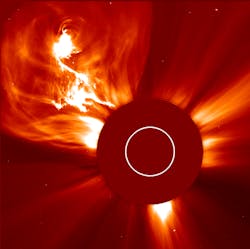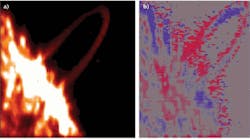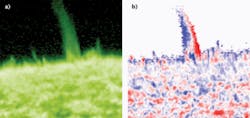PHOTONICS APPLIED: ASTRONOMY: Photonics plays critical role in understanding our Sun
The Sun plays a major role in our everyday lives, and numerous spacecraft have been launched in recent years to monitor its ejections and sunspot activity. Among them is the Solar and Heliospheric Observatory or SOHO—launched in 1995 to study the Sun from its deep core to the outer corona and the solar wind. Data from SOHO was recently used to show that x-rays, long thought to be the major output from solar flares, are only about 1% of the emitted radiation. The SOHO spacecraft, in a halo orbit 1 million miles outside Earth's magnetosphere (roughly 1% the distance from the Earth to the Sun) and bathed in constant sunlight, also confirmed that solar flares create a physical earthquake of sorts on the Sun. It continues to monitor the recent increase in sunspot activity (after a two-year low) that is potentially tied to Earth's weather and climate.
Imaging
The Extreme ultraviolet Imaging Telescope (EIT) has been described as the workhorse of SOHO (http://bit.ly/gvzsVk), sending back images of the Sun every 12 min—a frequency that illustrates the constantly changing dynamics of the solar corona that were not originally anticipated when the instrument was built. "EIT discovered one of the most intriguing manifestations of solar activity—eruptive events now called 'EIT waves' that can affect the global configuration of the corona," says Frédéric Auchère, EIT principal investigator and astronomer at the Institut d'Astrophysique Spatiale (Orsay, France). "Because of the exceptional longevity of SOHO, we can observe these waves and attempt to understand their relationship with other types of solar activity like coronal mass ejections," he adds (see Fig. 1).
The EIT is a full-solar-disk imaging telescope (Ritchey-Chretien design) with multilayer normal-incidence EUV optics and a spatial resolution of 5.2 arcsec. The telescope mirror is divided into quadrants with custom coatings of alternating molybdenum and silicon layers that isolate the emissions (only one quadrant is exposed at any one time) from narrow temperature ranges in four wavelength bands centered at 17.1, 19.5, 28.4, and 30.4 nm. These wavelength bands correspond to light from emission sources at particular temperatures; for example, the 30.4 nm band corresponds to the helium II emission from plasma at temperatures of approximately 8 × 104 K and images coronal loops and "holes" (locations of open magnetic fields) where high-speed solar wind streams originate. The full-disk images provide a context for narrower-field-of-view data gathered from other SOHO instruments.
Now semi-retired and transmitting just two solar images per day, SOHO's EIT has been superseded by images from the AIA aboard the Solar Dynamics Observatory (SDO) launched in 2010. The AIA resolution is 1.2 arcsec—4.3 times better than EIT. It also gathers data using a 16 Mpixel sensor compared to 1 Mpixel for EIT and images in eight passbands—twice as many as EIT.
Coronagraphy
The Large-Angle and Spectrometric Coronagraph (LASCO) from the Naval Research Laboratory (NRL; Washington, DC) aboard SOHO consists of three telescopes with successively larger occulting disks that block the central illumination from the sun, unveiling features in its outer corona (see Fig. 2). "We lost C1—a Fabry-Perot interferometric coronagraph with the smallest occulter disk for imaging from 1.2 to 3 solar radii—in the 1998 SOHO tumbling accident that brought instrument temperatures down to -80°C," says Russell Howard, LASCO principal investigator and NRL astrophysicist. "This was well below the -20°C tolerance for some of the optical components in C1. But when satellite control was resumed, C2 and C3—white light coronagraphs that image from 2–6 and 3.7–32 solar radii, respectively—were operating just fine. In fact," Howard adds, "we have observed only a 0.5% degradation per year in these systems—equally spread between the optics and the 1024 × 1024 pixel CCD and easily calibrated out—meaning that they still have more than 90% of their original imaging capability since launch in 1995."Howard points out that before SOHO, coronagraphs had fields of view of 6–10 solar radii. "The 30-plus solar radii imaging capability of LASCO has revealed a tremendous amount of detail in streamers and coronal mass ejections [CMEs]—those pure mass ejections of up to 90% protons, 10% helium, and other trace elements that may take a few days to reach Earth, but can potentially disrupt satellite communications and impact our climate and power grid," says Howard. "The larger field of view coupled with improved CCD sensitivity allows us to see objects 10 to 14 orders of magnitude dimmer than the Sun itself. We can see faint emissions that allow us to map the spatial trajectory and velocity of CMEs for better predictions as to whether and when they will impact Earth."
In addition to monitoring CME activity, LASCO is also looking at plasma streams, trying to understand why the lowest-speed solar winds associated with these bright emissions with weak magnetic fields (that typically maintain speeds between 300–400 km/s) are only reaching levels of 250 km/s in recent years, and how magnetic instabilities contribute to the emission of x-rays, gamma rays, and the UV energy of solar flares that can reach our Earth's ionosphere in less than 10 min.
Spectrometry
The Coronal Diagnostic Spectrometer (CDS) aboard SOHO is designed to probe the solar atmosphere by analyzing spectral emission lines in the extreme ultraviolet (EUV) region between 15–80 nm with a spectral resolution of 0.03 nm and a time resolution on the order of a few seconds—an improvement over earlier spectrometers launched in the 1970s and 1980s.1 By understanding coronal emission and ejecta at EUV wavelengths (accessible by spaceborne instruments only since Earth's atmosphere absorbs UV emissions from the Sun), the CDS aims to reveal how the solar corona is heated and how the solar wind is accelerated through analysis of the densities, temperatures, flow velocities, and abundances of trace-element ions (including helium, oxygen, magnesium, silicon, sulfur, and iron) formed in the hottest plasmas of the solar corona.The CDS instrument has a telemetry rate allocation of 11.3 kbit/s. Since the full CDS spectrum from its NIS spectrometer requires 3.5 million bits, it takes 6 min to send one full spectrum. But CDS operators often select several useful spectral bands that contain either the brightest lines or other lines that give a useful measurement of temperature or density for faster transmission in 10–60 s while the CDS is taking its next exposure.
In addition to CDS, SOHO houses the Solar Ultraviolet Measurements of Emitted Radiation or SUMER instrument, a UV telescope and high-resolution spectrometer with 1 arcsec resolution (equivalent to 715 km on the Sun's surface) designed to measure cooler-emission plasma lines in the wavelength region from 50–160 nm such as the Lyman series of hydrogen, the most abundant element in the universe. "In contrast to CDS, SUMER is mainly designed to observe the chromosphere and the transition region between the relatively cool solar surface and the hotter corona," says Werner Curdt, principal investigator for SUMER and senior scientist at the Max Planck Institute for Solar System Research (MPS; Lindau, Germany). "SUMER is designed with all-silicon-carbide optics that reflect down to 50 nm, and because CCDs have a poor response in this wavelength range, it uses a multichannel plate cathode attached to a photon-counting device that's ideal for low-signal applications," adds Curdt (see Fig. 5).Curdt says that the findings from SUMER over the past 15 years are documented in more than 1000 scientific articles in mostly peer-reviewed journals. He adds, "SUMER's spectral range and enormous spectral resolution allows the detection of Doppler shifts in spectral lines that correspond to line-of-sight bulk motion as low as 1–2 km/s; this makes it a unique instrument now and in the foreseeable future."
REFERENCES
1. R.A. Harrison et al., Solar Phys., 162, 233–290 (1995).
2. A. Fludra, Astron. & Astrophys., 368, 639–651 (2001).
Comet discoveryAn interesting accomplishment for LASCO is the December 2010 milestone discovery of its 2000th comet by amateur astronomer Michal Kusiak from Jagiellonian University (Krakow, Poland), one of many ‘citizen scientists’ that pore over LASCO’s publicly available images. Although it took ten years for LASCO to spot the first 1000 comets, it only took five more to find the next 1000 thanks to increased participation from the public, optimization of the images for comet sighting, as well as what is believed to be a recent comet storm. “Fortunately, 85% of these comets are sun grazers that enter at high inclination angles to our solar system’s ecliptic and are thought to be part of the Kreutz family from a large comet that broke up a long time ago,” says Howard. “Many of them are probably vaporized by the sun, but comet 96P Machholz has been seen by LASCO three times.”
About the Author

Gail Overton
Senior Editor (2004-2020)
Gail has more than 30 years of engineering, marketing, product management, and editorial experience in the photonics and optical communications industry. Before joining the staff at Laser Focus World in 2004, she held many product management and product marketing roles in the fiber-optics industry, most notably at Hughes (El Segundo, CA), GTE Labs (Waltham, MA), Corning (Corning, NY), Photon Kinetics (Beaverton, OR), and Newport Corporation (Irvine, CA). During her marketing career, Gail published articles in WDM Solutions and Sensors magazine and traveled internationally to conduct product and sales training. Gail received her BS degree in physics, with an emphasis in optics, from San Diego State University in San Diego, CA in May 1986.




